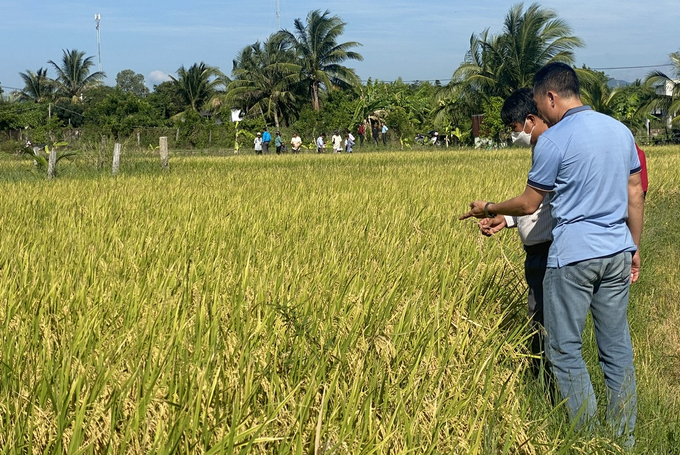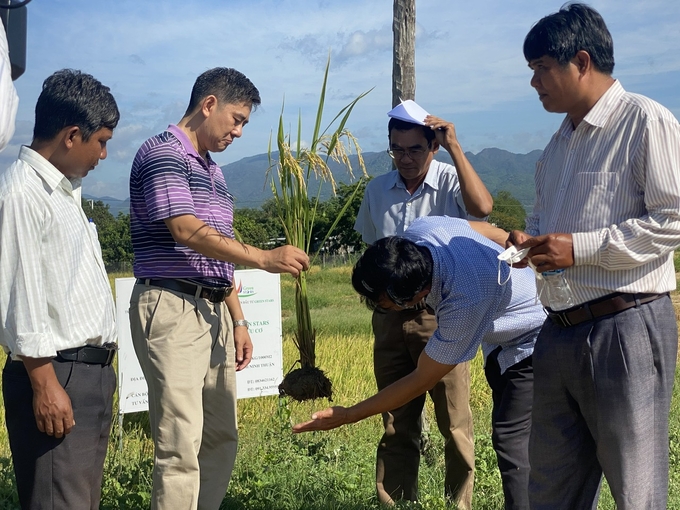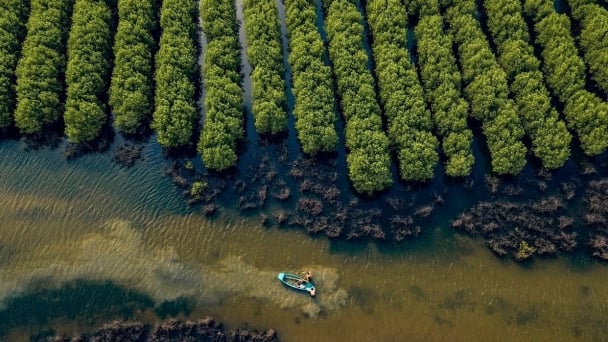June 13, 2025 | 15:49 GMT +7
June 13, 2025 | 15:49 GMT +7
Hotline: 0913.378.918
June 13, 2025 | 15:49 GMT +7
Hotline: 0913.378.918

The sowing is sparse, so the rice in the tillering model is strong, the rice spikelet are large, and bright, and the yield is higher than that of the local practice of thick sowing. Photo: Nguyen Co.
Nhi Ha commune, Thuan Nam district, Ninh Thuan is a rice-producing region that derives from the water resource of the Tan Giang River. The terrace field, sandy soil, proximity to hilly and mountainous regions, and the presence of numerous birds and mice are the causes of rice seed loss during sowing. As a consequence, farmers used to sow seeds densely, and it is difficult to change their mindsets.
In the 2023 summer-autumn crop, Ninh Thuan Agricultural Extension Center collaborated with Green Stars Investment Joint Stock Company to implement the organic rice production model utilizing "1 must 5 reductions" in Mr. Phung Van Tuan's household in village 3, Nhi Ha commune in order to disseminate knowledge about organic rice production and increase farmers' awareness of rice production so that they can replicate the model in the future.
The model has a size of 5,000 m2 (5 dunams), with plantings of Vietnam Fragrant Rice 5% broken or Dai Thom 8 rice varieties, a sowing quantity of 12 kg/dunam (down 60% from the previous model), and the use of Green Stars bio-organic and chemical fertilizers.
The monitoring of the model field has led to a reduction in the quantity of fertilizers and pesticides, as a result of the reduction in the number of seedlings. In addition, the Dai Thom 8 rice variety is confirmed to be of superior quality to the local traditional rice varieties (varieties TH6, TH41), so its selling price is higher.
On the other hand, organic rice production, which utilizes biological drugs in pest control, has reduced the number of chemical fertilizers, making it less harmful to the soil environment, eco-friendly, and rice products with guaranteed safety and quality, consistent with the agricultural industry's current development direction.

The roots of rice develop very well thanks to the application of "1 must 5 reductions" in production. Photo: Nguyen Co.
As a consequence, the model field yield is estimated to be 8.3 tons per hectare (at the same price of 7,500 VND per kilogram), and farmers earn more than 40 million VND per hectare, an increase of nearly 1 million VND per hectare over the conventional method. Even though the weather during the summer-autumn crop was quite complicated, both the model and control fields had pests, and there was heavy rain in the days leading up to the harvest, but the model rice fields remained resistant to lodging, and the rice plants remained verdant and upright.
Mr. Phung Van Tuan - the household participating in the model - is well-versed in traditional production methods. Initially, it was somewhat discouraging to see that the control field sowed densely and the rice turned green, while his model field sowed sparsely and the rice was only sparse. Nonetheless, the extension staff closely adhered to the model and directed the technical measures, and the end result altered Mr. Tuan's perspective.
"Now I see the benefit of sparse seeding compared to dense sowing as it has been for a long period. Next winter-spring crop, I will continue to implement the model and disperse sparingly, using 8kg of rice seeds to plant 5 dunams", eagerly said Tuan.
A Presidential decree (532-QD-TT-CLT) has designated 1 Must 5 Reductions (1M5R) as the national policy to promote best management practices in lowland rice cultivation in Vietnam. This management reduced production costs by 23%, decreasing output by 203 US$/ha per season, and increased income by 19%, or by 175 US$/ha. The adoption of this technology was 28% more advantageous than the adoption of 1M5R by producers.
The central concept of 1M5R is the use of high-quality, certified seeds (the One Must Do) and the reduction of seed rates, pesticide use, fertilizer inputs, water use, and postharvest losses (the Five Reductions). However, the effects of these agricultural practices are poorly understood.
A household survey of 380 rice plantations in four provinces of the Mekong Delta, Vietnam, was used to acquire primary data. The results indicate that the adoption of the 1M5R technique is significantly correlated with the level of education of household chiefs, their membership in paddy cooperatives, and their participation in previous training classes.
Translated by Linh Linh

(VAN) In Tien Giang, a high-tech shrimp farm has developed a distinctive energy-saving farming model that has yielded promising results.
![Turning wind and rain into action: [3] 300.000 farmers benefit from agro-climatic bulletins](https://t.ex-cdn.com/nongnghiepmoitruong.vn/608w/files/news/2025/06/12/e5a48259d6a262fc3bb3-nongnghiep-125122.jpg)
(VAN) The agro-climatic bulletin has become a valuable tool for farmers in the Mekong Delta. After more than five years of implementation, the initiative is gradually being expanded nationwide.
![Turning wind and rain into action: [2] Providing forecasts to the people](https://t.ex-cdn.com/nongnghiepmoitruong.vn/608w/files/news/2025/06/12/e5a48259d6a262fc3bb3-nongnghiep-103927.jpg)
(VAN) In addition to improving the quality of hydrometeorological forecasts, putting forecast bulletins into practical use is crucial for production and disaster prevention.

(VAN) Blue carbon is receiving attention for its rapid absorption capacity and vast potential. It represents a promising nature-based solution to respond to climate change.
/2025/06/11/3507-1-161904_583.jpg)
(VAN) Seagrass beds and coral reefs serve as 'cradles' that nurture life in the ocean depths, creating rich aquatic resources in Vietnamese waters.
![Turning wind and rain into action: [1] Forecasting for farmers](https://t.ex-cdn.com/nongnghiepmoitruong.vn/608w/files/news/2025/06/11/e5a48259d6a262fc3bb3-nongnghiep-111919.jpg)
(VAN) Weather is no longer just a matter of fate. Forecasts have now become an essential companion for farmers in every crop season.
/2025/06/10/2501-3-082025_983.jpg)
(VAN) Mr. Le Hoang Minh, Head of Vinamilk's Net Zero project, recently shared insights on the integration of production, energy, and technology in Vinamilk’s green transition journey.